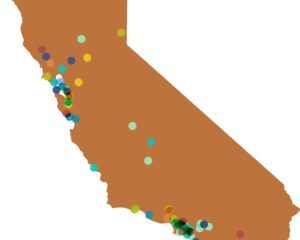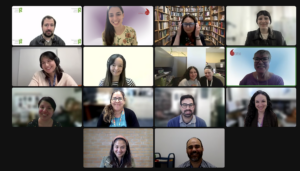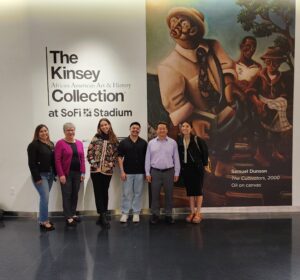“Everything tastes better when you share,” I used to say to my kids when they were young, referring not only to food, but to ideas, experiences, perspectives. Earlier this month, nine California Humanities staff members and our Board Chair had an opportunity to partake of all of those things at the National Humanities Conference. An annual event produced by the Federation of State Humanities Councils, this is the third year that it was presented in partnership with the National Humanities Alliance, bringing together close to 600 state humanities council staff and board members as well as academic humanities practitioners. The conference was anchored by remarkable keynote speakers, including the Chairman of the National Endowment for the Humanities, Jon Parrish Peede, authors Jesmyn Ward and Kiese Laymon, and ethnomusicologist Dr. Michael White. We are grateful for the efforts the conference planning committee and the Louisiana Endowment for the Humanities made in grounding us in the remarkable history, culture, and geography of New Orleans. The opportunity to share the work all of us are doing in service of building bridges of understanding between people through the humanities led to rich and often delicious experiences, as articulated by the reflections of my colleagues below. – Julie Fry, President and CEO
These annual conferences are always a wonderful opportunity to see old friends and make new acquaintances, to learn about the good work being done by our colleagues across the nation and to share ours, and to experience a new place. This year’s conference was especially rich, being set in New Orleans, a city with a rich and complicated history that embodies so many of the contradictions of our collective life and the challenges (and opportunities) we face as a people. The organizers drew upon the wealth of resources the city and region offered in planning the sessions and presentations. For me, the culminating presentation by jazz great and musicologist Dr. Michael White, accompanied by three other master musicians, was literally the high note of the meeting and a perfect culmination to our time together, demonstrating how the humanities can be used to educate, surprise, delight, connect, and inspire. – Felicia Kelley, Project and Evaluation Director
This was my first National Humanities Conference. It was also my first visit to New Orleans. Both firsts were eye-opening. I didn’t know what to expect from the humanities councils. I was surprised and moved by the amount of social justice, site-specific work that so many organizations were doing. Two projects particularly stood out. First, there was the Envisioning Justice project from Chicago, with its focus on art and restorative justice. The second was the Purchased Lives exhibit and traveling exhibition from the Louisiana Historical Society. The presenters talked about the difficulty of making documents come to life for 21st century audiences and the important conversations the traveling exhibit seeded across the state. They were also pretty funny about the challenges of moving 10 panels from town to town. (It turns out that 600-pound cases are not a great idea.) – Renée Perry, Operations Coordinator
For me, one of the most memorable parts of this year’s National Humanities Conference in New Orleans was the opening keynote speech given by Dr. Richard Campanella, Associate Dean for Research, Senior Professor of Practice—Architecture and Geography at Tulane University. In this presentation Dr. Campanella synthesized how several millennia of geographic activity has shaped how we visualize, experience and think about the geography of New Orleans. Dr. Campanella punctuated his discussion with a rebus of images that included an accordion, a dinner plate, a pot of gumbo, and green dot (among a few examples) to trace the variety of metaphors and symbol that have come to describe shifting cultural and spatial contexts for understanding New Orleans. As a first-time visitor to New Orleans, Dr. Campanella’s presentation helped me understand the complex and intersecting factors that have shaped the complex geographies of place shared through humor, science and history.
After this presentation, I’m left considering how the flow of water and deposition of silt, coupled with different systems for the demarcation of land, and the forces of climate change have all hand a hand in the formation of New Orleans as we know it today. I appreciated the deeper sense of meaning Dr. Campanella’s presentation gave to my time in New Orleans. As my plane departed for Los Angeles, I tried to look for the French long lot lines used by early French colonists to divide property lines throughout the state’s parishes. This presentation was a beautiful way to think through how the humanities can help us connect to and understand the sciences, and perhaps vice versa. – Lucena Lau Valle, Associate Program Officer
I was particularly moved by a session titled “Humanity (ies) in the path of the Hurricane,” in which attendees watched a documentary directed by Sonia Fritz, Maria: Las dos Orillas (The Two Shores of Maria). The film explored the aftermath of Hurricane Maria in Puerto Rico through a humanities lens. Following the screening, attendees discussed how natural disasters impact communities, as well as other subjects the film touched upon including migration, climate change, ecology, cultural traditions, and the special connections and systems of support that exist within the Puerto Rican diaspora. This was my final session of the conference and a truly inspiring end note.
I was also inspired by a team of staff members and consultants who shared the story of Humanities Kansas’s rebranding. Their enthusiasm was infectious as they described their process, shared some of the tools they developed to showcase Humanities Kansas’ “movement of ideas,” and explained how they came to be wearing matching outfits! – Sheri Kuehl, Director of Development
I was inspired by the work of the New Orleans-based public humanities project Paper Monuments. Paper Monuments brings together people from the community of New Orleans including artists, historians and thinkers to consider what their history means to them, surface sometimes-lost histories and bring these histories into the public sphere through posters. The community was invited to submit their proposals on paper for an artist to design a monument made out of paper and the handwritten and hand-drawn proposals starting arriving. These regular sized and large-scale posters feature newly created art and accompanying text, and populate the streets of New Orleans.
Three posters I saw seemed weather-beaten and offered me vignette views into the past. One poster featured a self-sufficient and embattled maroon (escaped slave) community on the Mississippi River. Another told the story of a multiracial general strike started by teamsters, scalesmen, and packers in 1892.
Project co-organizer Sue Mobley told about a community member who works on Canal Street who saw a poster describing an event that he had experienced in his own childhood: At the age of 12, he had seen tanks storm into a housing project to dismantle a Black Panther Party-run breakfast program. After reading the Paper Monuments poster, the community member introduced young people waiting for buses and other passers-by to the poster, becoming a volunteer docent for this particular poster.
I am in awe of how this project brings people together to think and create together. I’m intrigued by the idea that we can redefine not only who or what we memorialize, but what we mean when we think of the idea of a monument. I usually associate the term with metal figures, domineering scale, and plaques with opaque language. This project turns the term on its head and opens up the possibility to reconsider a monument to be something that can be made of paper, pasted to a wall, be one of a series, or be growing continually into a monumental collection—a body not cast in bronze but a body of work. And this opening up of possibilities in words inspires me to think about other possibilities for the exchanges between people living in community and making meaning out of their pasts and their future.—Lucy Boltz, Program Assistant
The sessions I attended at the conference made me reflect on identity, words and things we use to identify ourselves and others. At the session on engaging immigrant communities, led by California Humanities staff, an attendee posed the question to the group, “As a Caucasian woman, are there places I should not go?” in reference to the spaces immigrant groups identify as their own. Council staff wanted to find out how to reach people who identify within their ethnic groups, and to find out what programs these groups desire, without encroaching on “safe space.”
The thoughts continued as I listened to the keynote by Dr. Richard Campanella on the eighteen metaphors that define or identify New Orleans. Do people who were born and live in New Orleans identify with these metaphors? How does connection with those metaphors relate to the words they would use to identify themselves? How do places help us identify ourselves?
In the session titled “Chew On This: Does Place-Making Make Better Cities”, we were asked to identify a special place in the city from which we came and share what makes it special. My place was the Houston Astrodome, because it was the first domed stadium. Some people described very private places like their backyards and the special quality of each was intrinsic to their identity. The conversation broadened into what makes a public space as special. Because my initial response was to think of a stadium and almost everyone else described a park or other outdoor space, I wondered about how we identify with places and use places to identify ourselves. – Debra White, Grants Manager
This year’s National Humanities Conference proved to be exciting and informative. I found two sessions particularly impressive. One session presented the story of the Jesuits in Maryland who financed the education of white male students at Georgetown University by engaging in slave trading. This presentation illustrated the cooperative work of academicians and community members—the descendants of slaves sold by the Jesuits—in researching this hidden part of our history and telling its story to the public.
Another valuable session featured the efforts of humanities groups in Wyoming, New Jersey and Rhode Island in identifying best practices in qualitative and quantitative tools for grantees.— Mary Valentine, Board Chair
The 2018 National Humanities Conference in New Orleans is the fifth that I’ve been fortunate enough to attend. Each time it’s been a pleasure to reconnect with a longstanding network of colleagues from other states, as well as the NEH. Most notable this year however was the large number of new, recently-hired colleagues from humanities councils around the country who brought noticeable energy and socially-engaged perspective to the group. To me, this new cohort dedicated to the public humanities seems like a pretty good sign for a field that is often written off as in crisis. That and New Orleans was pretty fun, too.— John Lightfoot, Senior Program Officer
As the newest California Humanities staff member, this year was my first time at the National Humanities Conference – it actually took place my first week on the job! New Orleans is a city I love – I spent three months living there doing relief work after Hurricane Katrina and have always held it and the people there dearly. Being back for the conference, I was struck by how many parallels I drew between New Orleans and the Bay Area where I live. From the incredible food culture to the homegrown music, to the efforts to preserve history and also to welcome newcomers within a changing coastal state, I found many ways that the regions are similar, despite the significant differences that exist between the West and the South. Being there during the first week of the devastating California wildfires heightened this comparison for me. I watched from afar as people fled the natural disaster, and observing how communities came to each other’s aid reminded me of my time spent living in NOLA after Katrina.
The conference reinforced these observations, and expanded my comparison with New Orleans to many other states – I attended sessions led by state humanities organizations of Indiana, Kansas, Louisiana, Florida, New York, Minnesota, and many more. We learned about how other states are using the humanities to bolster communities in the wake of natural disasters, and how they’re making programming more relevant and accessible to immigrants. I was inspired hearing about the amazing work going on in the 56 other state and territorial humanities councils. I hope that moving forward we can maintain this sense of connection across the country and share the valuable lessons and inspirations that make our work in the humanities so meaningful.—Claudia Leung, Communications Manager





